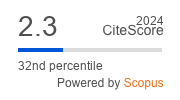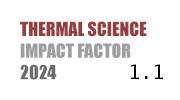THERMAL SCIENCE
International Scientific Journal
Authors of this Paper
External Links
EFFECT OF MIXING CHAMBER STRUCTURE ON THE PERFORMANCE OF ADJUSTABLE EJECTOR
ABSTRACT
The study employs numerical simulation method to analyze performance of an adjustable ejector, with a specific focus on the influence of the structure dimension of mixing chamber. The R41/R1234yf refrigerant is used as the working medium in the study. The primary and secondary flow inlets are set at the pressure of 1.4 MPa and 0.2 MPa, respectively, along with temperature of 353.15 K and 288.15 K corresponding. The outlet pressure of the ejector is 0.3 MPa. The simulation results show that optimal mixing chamber diameter within a range from 14.7 mm to 18.7 mm exists for obtaining peak adjustable ejector performance. Maximum entrainment ratio of 0.59 is obtained when cone diameter ratio is 65% and diameter of the mixing chamber is 15.7 mm. Furthermore, the optimal mixing chamber length within range from 24 mm to 220 mm exists for obtaining peak adjustable ejector performance. Maximum entrainment ratio of 0.624 is obtained when cone diameter ratio is 76% and length of the mixing chamber is 88 mm. Therefore, it is crucial during designing process of the mixing chamber to ensure the complete fluid mixture and minimal flow resistance.
KEYWORDS
Adjustable ejector, performance optimization, numerical simulation, Mixing chamber dimensions, Entrainment ratio
PAPER SUBMITTED: 2024-07-14
PAPER REVISED: 2024-08-23
PAPER ACCEPTED: 2024-08-31
PUBLISHED ONLINE: 2024-10-12
DOI REFERENCE: https://doi.org/10.2298/TSCI240714229Z
CITATION EXPORT: view in browser or download as text file
PDF VERSION [DOWNLOAD]
2025 Society of Thermal Engineers of Serbia. Published by the Vinča Institute of Nuclear Sciences, National Institute of the Republic of Serbia, Belgrade, Serbia. This article is an open access article distributed under the terms and conditions of the Creative Commons Attribution-NonCommercial-NoDerivs 4.0 International licence

